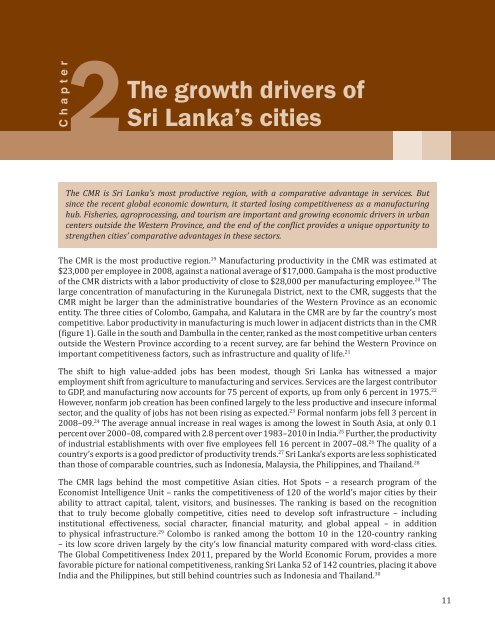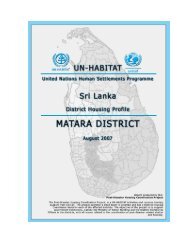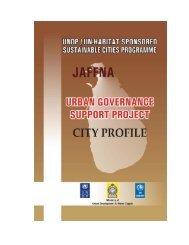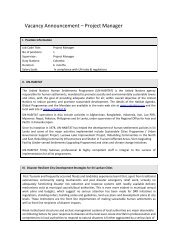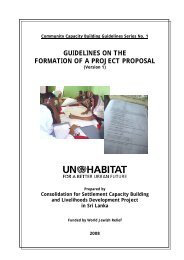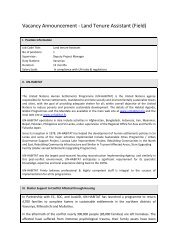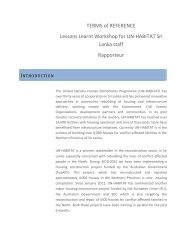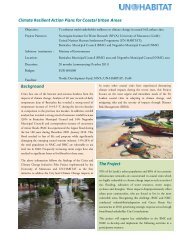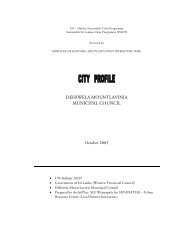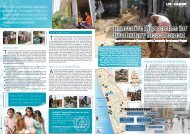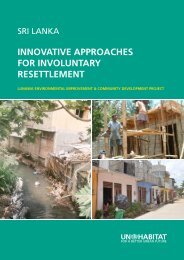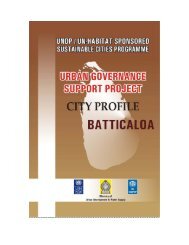Turning Sri Lanka's Urban Vision into Policy and Action - UN HABITAT
Turning Sri Lanka's Urban Vision into Policy and Action - UN HABITAT
Turning Sri Lanka's Urban Vision into Policy and Action - UN HABITAT
Create successful ePaper yourself
Turn your PDF publications into a flip-book with our unique Google optimized e-Paper software.
Chapter TwoChapterThe growth drivers of2<strong>Sri</strong> Lanka’s citiesThe CMR is <strong>Sri</strong> Lanka’s most productive region, with a comparative advantage in services. Butsince the recent global economic downturn, it started losing competitiveness as a manufacturinghub. Fisheries, agroprocessing, <strong>and</strong> tourism are important <strong>and</strong> growing economic drivers in urbancenters outside the Western Province, <strong>and</strong> the end of the conflict provides a unique opportunity tostrengthen cities’ comparative advantages in these sectors.The CMR is the most productive region. 19 Manufacturing productivity in the CMR was estimated at$23,000 per employee in 2008, against a national average of $17,000. Gampaha is the most productiveof the CMR districts with a labor productivity of close to $28,000 per manufacturing employee. 20 Thelarge concentration of manufacturing in the Kurunegala District, next to the CMR, suggests that theCMR might be larger than the administrative boundaries of the Western Province as an economicentity. The three cities of Colombo, Gampaha, <strong>and</strong> Kalutara in the CMR are by far the country’s mostcompetitive. Labor productivity in manufacturing is much lower in adjacent districts than in the CMR(figure 1). Galle in the south <strong>and</strong> Dambulla in the center, ranked as the most competitive urban centersoutside the Western Province according to a recent survey, are far behind the Western Province onimportant competitiveness factors, such as infrastructure <strong>and</strong> quality of life. 21The shift to high value-added jobs has been modest, though <strong>Sri</strong> Lanka has witnessed a majoremployment shift from agriculture to manufacturing <strong>and</strong> services. Services are the largest contributorto GDP, <strong>and</strong> manufacturing now accounts for 75 percent of exports, up from only 6 percent in 1975. 22However, nonfarm job creation has been confined largely to the less productive <strong>and</strong> insecure informalsector, <strong>and</strong> the quality of jobs has not been rising as expected. 23 Formal nonfarm jobs fell 3 percent in2008–09. 24 The average annual increase in real wages is among the lowest in South Asia, at only 0.1percent over 2000–08, compared with 2.8 percent over 1983–2010 in India. 25 Further, the productivityof industrial establishments with over five employees fell 16 percent in 2007–08. 26 The quality of acountry’s exports is a good predictor of productivity trends. 27 <strong>Sri</strong> Lanka’s exports are less sophisticatedthan those of comparable countries, such as Indonesia, Malaysia, the Philippines, <strong>and</strong> Thail<strong>and</strong>. 28The CMR lags behind the most competitive Asian cities. Hot Spots – a research program of theEconomist Intelligence Unit – ranks the competitiveness of 120 of the world’s major cities by theirability to attract capital, talent, visitors, <strong>and</strong> businesses. The ranking is based on the recognitionthat to truly become globally competitive, cities need to develop soft infrastructure – includinginstitutional effectiveness, social character, financial maturity, <strong>and</strong> global appeal – in additionto physical infrastructure. 29 Colombo is ranked among the bottom 10 in the 120-country ranking– its low score driven largely by the city’s low financial maturity compared with word-class cities.The Global Competitiveness Index 2011, prepared by the World Economic Forum, provides a morefavorable picture for national competitiveness, ranking <strong>Sri</strong> Lanka 52 of 142 countries, placing it aboveIndia <strong>and</strong> the Philippines, but still behind countries such as Indonesia <strong>and</strong> Thail<strong>and</strong>. 3011


